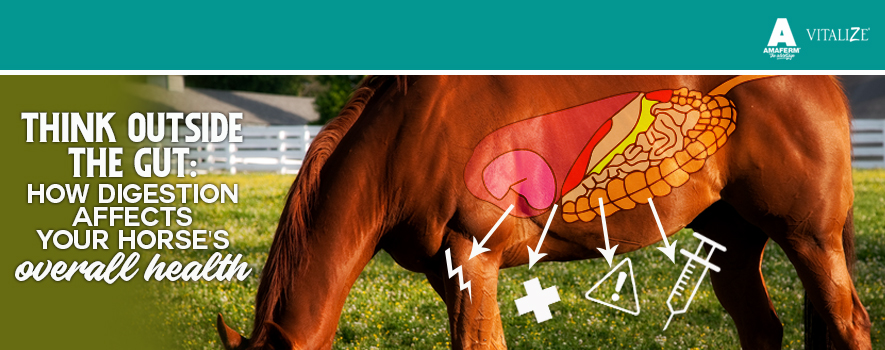
Gut health affects many aspects of equine wellness. The most intuitive, of course, is digestion and absorption of feed. However, the gut truly plays a role in almost all facets of health and well-being. Take immunity for example. The gut is paramount to having a healthy and responsive immune system. In fact, over 70% of all the body’s immune cells are found in the gut. Improving the gut’s immune response isn’t only important for protecting against pathogens consumed, in addition, several studies have demonstrated that good gut health, and the subsequent efficacy of the gut immune cells, is important for defense against infections, respiratory diseases and even cancer.
Interestingly, the good microbes that live in the gut also have a responsibility to protect the body from the bad microbes (pathogens) that may try to enter. First, they compete with pathogens for space and food in the gut. When the good outnumber the bad, it becomes easy to eliminate pathogens. Second, the good microbes improve overall gut health and strengthen the physical and chemical defense mechanisms of the gut. Physically, good gut microbes initiate immune functions in the cells lining the gut wall, ensuring those cells will do their job. Chemically, good gut microbes prevent against infection by keeping the gut acidity, or pH, correct. The gut was designed to be relatively acidic for a reason, to make it a hostile environment for pathogens trying to invade the body. Keeping the pH at the right level, not too high and not too low, is a key to good gut health and very important to the immune function of the gut.
When alterations to the pH do occur, the result can be disastrous. One example is laminitis or founder. Laminitis refers to the inflammation of the laminae (tissue located between the hoof wall and the coffin bone). You may be asking yourself, “What does the gut have to do with inflammation in the feet?”. As horses have become domesticated and modernized, horse owners tend to feed larger, less frequent, less fibrous meals than the grazing horse is meant to consume. Occasionally, this may become a problem because the horse’s stomach is very small and intended for grazing, slowly eating all day long. In a recent interview with 10-time Olympic show jumper Ian Millar, Ian told us a fact that guides his nutritional program. “The stomach is only the size of a football,” he said. “Did you know that?”
The small stomach size presents a challenge when feeding large amounts of grain, which are meant to be digested in the foregut. This challenge is exacerbated by the fact that the bigger the meal, the faster it moves through the stomach. The fast rate of passage and tendency to feed grains in high quantities, especially in the performance horse, means digestion may not have time to be completed. If this is the case, undigested starches get into the hindgut where they are fermented by a particular type of gut microbe that produces lactic acid. From here, the pH of the hindgut decreases due to the lactic acid, the good fiber-loving bacteria start to die off, and, as they die, endotoxins are released. As the last part of this perfect storm, these conditions cause the integrity of the gut to often be compromised, meaning those endotoxins are now able to enter the bloodstream.
Exactly how these changes in the gut cause laminitis remains largely undetermined. However, it is a phenomenon that is well agreed upon by equine nutritionists and veterinarians. Luckily, it is preventable by managing a horse’s nutrition program and feeding smart. This means providing plenty of forage (at least 1.5% of the horse’s body weight per day) and feeding small meals frequently instead of larger ones less often. By the way, a prebiotic, like Amaferm®, can also help prevent or reduce the effects of these gut changes, should the perfect storm arise.
If you became a little queasy when we mentioned lactic acid being produced in the gut, then it shouldn’t be too difficult to convince you there is a connection between the gut and brain as well. Perhaps surprising to most of us, there is actually a direct physical connection from the gut to the brain called the vagus nerve. In addition, the gut and brain also communicate with one another via hormones or neurotransmitters. You may have heard of serotonin before, a neurotransmitter that helps maintain a good mood. Serotonin is well known as a neurotransmitter found in the brain. However, scientists believe nearly 90% of all serotonin is produced in the gut, making the gut a key player in behavior.
The gut also produces over 40 other neurotransmitters that are also found in the brain. Forty! The more we research the gut-brain axis, the more validity there is to gut feelings. In fact, researchers are beginning to find more and more associations between the types of microbes living in the gut and conditions like anxiety, depression and mental illness that may negatively impact behavior. Plus, if you recall the last time you had a stomach ache, you probably weren’t in a good mood just from the pain alone.
In conclusion, not only does the gut contribute to digestion and absorption of nutrients, it also plays a significant role in immune function, disease and behavior. So, next time you prepare a meal for your horse, think outside the gut.

